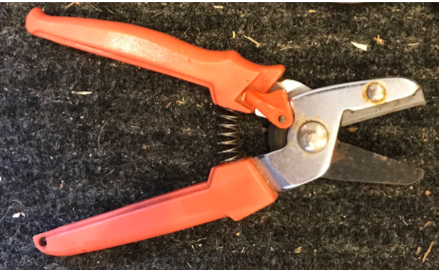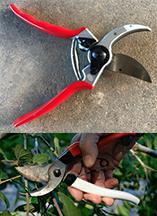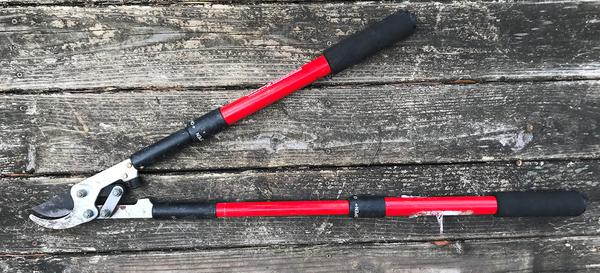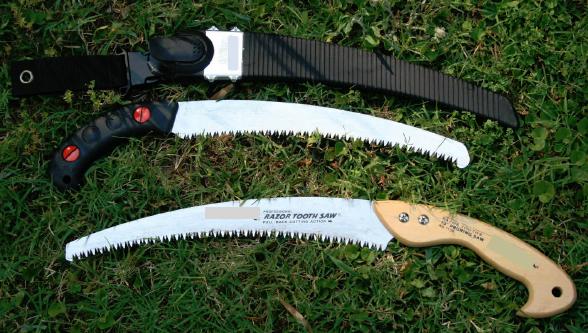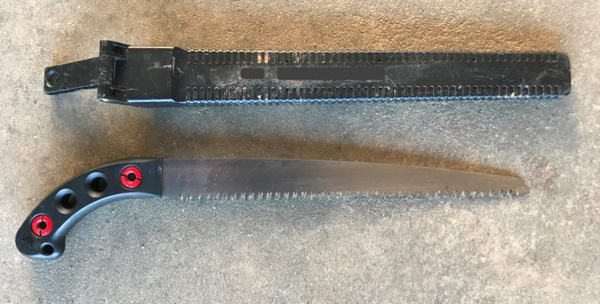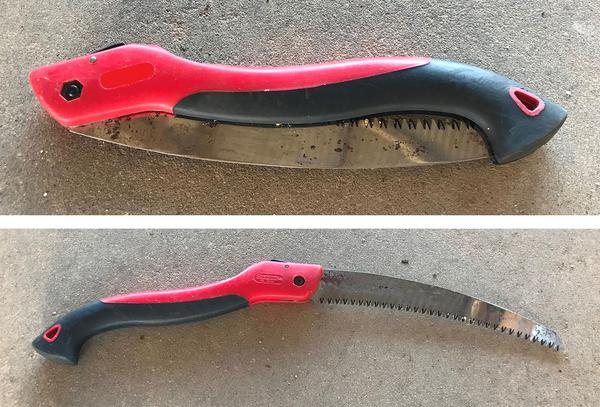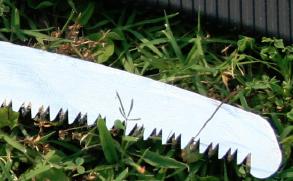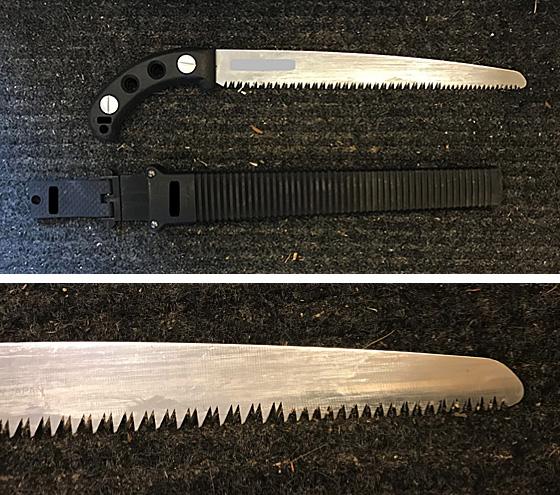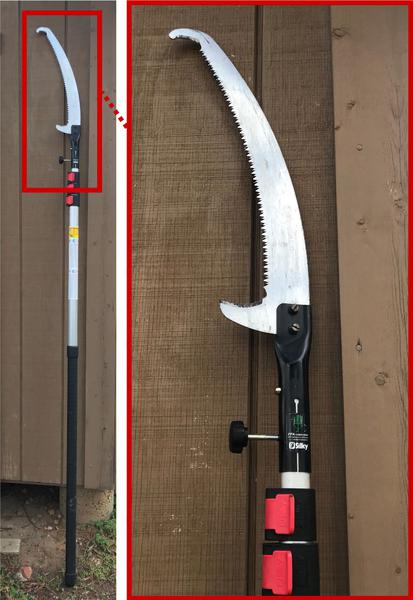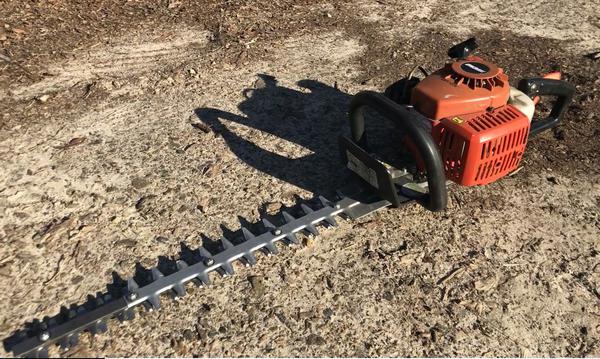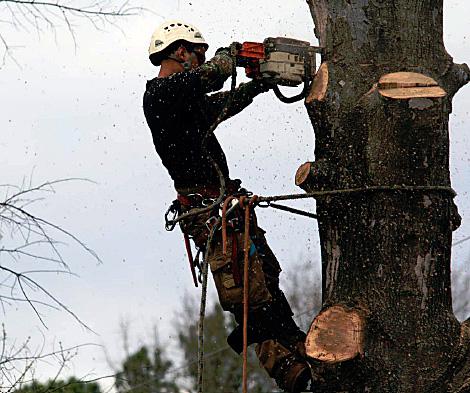Many different pruning tools are available in the trade. The types of tools you will need depend on the size of plant you intend to prune. Quality and price vary dramatically among tools. Here, we offer tips on selecting the right tool for the job and for evaluating a tool’s quality. Check the feel of several styles, as each design is unique. Any tool can cut, but if it is not comfortable to use, then it is of little use. High-quality tools will cost more but will last longer if taken care of and are often worth the expense.
Pruning Shears
Use pruning shears to cut small limbs, typically less than ½ inch in diameter. There are two styles of pruning shears: anvil and bypass (Figure 1). Anvil style shears have one sharpened blade that cuts into a thicker, flat anvil (Figure 2A).
Many people consider anvil shears to be poor-quality tools, but this is not necessarily true. Newer designs have a curved anvil and blade rather than the typical flat style, and this creates a much cleaner cut (Figure 2B).
Select a brand made with high-quality steel that fits your hand well, has a slim cutting-head, and a curved blade or anvil that prevents crushed stems.
Another type of pruning shears called bypass shears works almost like scissors (Figure 3). They have one sharpened blade that slices past the curved anvil. When sharp, they make clean cuts and get into small branch angles easily. Some shears have a hooked end to prevent branches from slipping, while others have a ratchet action to cut through slightly larger diameter stems. There are numerous brands available for both anvil and bypass shears, ranging in cost from about $25 to more than $90.
There are other hand shears—scissor, bonsai, and ratchet—used for special pruning projects. All of these tools work similarly to bypass pruners but with differently shaped blades.
You can use scissor shears for deadheading, cutting flowers, or pruning herbaceous plants.
Bonsai shears have strong but fine-pointed ends for snipping in tight places that are typical of many bonsai plants. They do come in different sizes to accommodate various-sized bonsai plants and to accomplish different pruning goals.
Ratchet pruners have an extra mechanism that allows you to cut with less hand strain. As you squeeze the pruners they latch so you can release and squeeze again. Each time you squeeze, the ratcheting mechanism clicks and moves to the next setting, providing ever-increasing pressure as you cut.
No matter the type of hand pruners you choose, never cut a stem too big for your tools. You will know this is happening if you have to squeeze too tightly to make the cut. Not only will you damage the tissue of the plant, but you may damage your pruners.
Loppers
Use loppers to prune branches that are ½ inch to about 1½ inches in diameter. Loppers also come in anvil or bypass style (Figure 4), and some brands may offer the ratchet style. They are available in various lengths—from about 20 to 40 inches. Some styles have handles that telescope for a longer reach, and some have a fixed length (Figure 5). Any extra mechanisms, such as gears or ratchets, add weight that can make the tool cumbersome if working for long hours and will likely cost more. Handles are made of wood, metal, or fiberglass.
For big jobs, there are also pneumatic, hydraulic, and electrically operated shears or loppers. Again, weigh the pros and cons of each brand and style. Try them out if possible, and select the best tool you can afford for the types of jobs you most commonly encounter.
Hand Saws
When cutting larger branches and limbs (larger than 1½ inches in diameter), you will likely need a pruning saw. If there is a question as to whether the job calls for loppers or a hand saw, it is often best to choose the saw. The saw can get into tighter places and make a much cleaner cut with less likelihood of crushing plant tissue. There are a number of brands, lengths, and styles. Some have a hooked end to help keep the saw in the cut; some have a curved blade (Figure 6A), while others are straight (Figure 6B). There are also folding saws (Figure 7). Most of the newer saws have blades that cut only on the pull stroke. This means you can put more power into the cut and wield greater control. Tool designers refer to these saws as turbo, tri-edge, and three-angled (Figure 8). The teeth are three-beveled, which allows for a fast, smooth cut with little clogging or gumming. There are a number of excellent options available. There are also saws that have smaller teeth on the pointed end and larger teeth on the back portion of the blade (Figure 9). The intent is to get the cut started with finer teeth. Prices vary quite a bit—from less than $15 to more than $100. Try several saws, and select the one that works best for you. When you buy a saw, be sure to purchase a scabbard or sheath (Figure 10) to protect your investment. Many of the good saws come with a scabbard made for that specific model.
Pole Pruners or Saws
If you need to cut above your head, select a pole saw or pruner (Figure 11). There are options that have both saw and pruner heads, but these tend to be much heavier. The best one to use depends on the branch size, branch angle, angle of cut, and the purpose of pruning. Working above your head is challenging for many reasons. It is hard on the neck, arms, and upper back, so be sure to take sufficient rest breaks to minimize any long-term injuries. In addition, it is difficult to achieve the proper cutting angle. Therefore, the pruning wound may not be properly located. Do the best you can, or hire an arborist to climb the tree and make the cuts. You can also rent a cherry picker or bucket truck to prune taller trees, both of which get you closer to the branches and make pruning much easier. It is best not to prune from a ladder, unless you are an experienced arborist.
Newer pole saw and pruner designs use relatively rigid aluminum. The poles come in sections, are quick locking, and are oval shaped, which allow for smooth sliding through your hands and easier cutting. Fiberglass is lighter but very flexible, which makes control more challenging. Dielectric fiberglass poles made especially for tree clearance work do not conduct electricity, and the aluminum poles often have a handgrip made of nonconductive material. However, you MUST BE specially trained and certified to work around electrical utilities. (A person who can do this is called a utility arborist.) Without such training, bring in a certified arborist with the proper accreditation. This is true no matter what work you are doing around electrical lines! To learn more about hiring a certified arborist or tree care professional, see How to Hire a Tree Care Professional (NC State Extension publication AG-691).
Bow Saws
Bow saws have a straight, sharp, quick-cutting blade. Most people do not use these for pruning because the shape prohibits use in tight branch unions. Use a bow saw to cut downed wood, debris, or firewood (if you are looking for a good workout!).
Chainsaw
Chainsaws are highly efficient, albeit potentially dangerous tools. Most arborists or tree climbers use chainsaws (Figure 12) quite skillfully to remove and prune larger trees and limbs. Chainsaws are invaluable when doing prolonged pruning of large-diameter limbs and ground clearance work. However, you should use a chainsaw only after proper training. If you are the foreman of a team, you must ensure that your employees are properly trained in the safe use of chainsaws according to Occupational Safety and Health Administration (OSHA) standards. Remember, as with anything you do in the landscape, use proper personal protective equipment (PPE), which could include eye protection, hearing protection, chaps, head protection, and steel-toed boots. Similar basic PPE is needed whether you’re operating a chainsaw or a gas-powered pole saw.
Clearing brush is one of the most dangerous landscape maintenance tasks. For clearing brush, you must wear eye and ear protection and may need chaps and gloves (in some cases).
There are numerous chainsaw brands available, some gas powered and others electric or battery operated. Select the one that fits your needs and budget. Prices vary dramatically.
For Consumers With Only Occasional Cutting Needs
Homeowners typically need a chainsaw to clean up after a storm, remove small trees or large shrubs, and to cut firewood. If this is the case, you do not need a professional-grade chainsaw; you need an easy-starting engine and basic safety features. Select the size saw for the size material you will be typically cutting. Invest in safety versus size. It is unlikely you will need a chainsaw with a bar length of more than 16 inches for most common household uses.
A chainsaw has three major components—an engine, bar, and chain. Most manufacturers design chainsaws with numerous safety and ease-of-use features. Gas chainsaws have a two-cycle engine that requires a mixture of gas and oil in the tank. This mix supplies fuel and lubrication so you do not need to perform oil changes. There is also a portal to add bar oil, which ensures that the cutting chain slides smoothly. Select a chainsaw model that has an automatic bar oiler and a vibration-dampening feature. Weights will vary based on the size of the chainsaw, but the vibration is what will really tire you out!
A real necessity is a chain brake. One of the most common causes of serious chainsaw-related injuries is kickback. Kickback can occur when the moving chain at the tip of the guide bar touches an object or when the tip is pinched by the wood. These actions can cause a very fast reverse action, sending the bar up and back toward the operator. This can cause you to lose control of the chainsaw and lead to serious injury to you or anyone around you. The chain brake stops the chain, thereby reducing the extent of injuries.
A well-maintained chainsaw will last for years. Learn how to clean it, replace the spark plug, sharpen the blades, change and adjust the chain, and complete other maintenance tasks.
There is nothing wrong with selecting an electric or battery-powered chainsaw (Figure 13), particularly if you infrequently need one. Consider the following tips before deciding on an electric, battery-powered, or gas-powered model.
- An electric or battery-powered chainsaw has less power and will increase the time you spend cutting. Less power, however, does not mean that you should be less vigilant about safety!
- Electric or battery-powered saws are not designed for prolonged use or for cutting large material.
- Electric saws often have only 100 feet of cord, while battery-powered saws are much more portable.
- Electric or battery-powered saws are often lighter and may offer greater safety features.
- Electric or battery-powered chainsaws are typically cheaper and require less maintenance.
- Electric or battery-powered saws are great for small, infrequent tree and shrub projects.
For Professionals
Professional chainsaws offer different features. Professionals use chainsaws when climbing in a tree, which requires a lightweight model, and to cut down large trees, which requires a large chainsaw with a long bar. Manufacturers design these chainsaws to run every day and to operate all day. They have a very rugged design.
Some models have a top handle. These models are often lighter and allow for greater mobility and accuracy when pruning tree branches. Make sure the saw you select has a balanced design. One with the engine inline directly behind the cutting bar offers the most balance and makes it easier to hold, thus reducing hand stress.
Some professional-grade models also offer two-year commercial-use warranties. These may be hard to find but are important if you use your chainsaw eight hours or more every day.
Hedge Shears
Most landscapers have some type of formal shrubs to maintain, so hedge shears (Figure 14) are a necessary tool. You can find hedge shears in gas, electric, battery-powered, and manual models. Which you choose depends on how many plants need shearing. Most professionals have both manual and gas-powered shears on hand. The key to quality projects is to ensure that your shears are sharp, particularly the manual version. Manual hedge shears come in several lengths with either straight or wavy-edged blades. Some users find the wavy-edged style cuts better. Manual hedge shears cost about $20 to $90, while the gas-powered models (Figure 15) run about $150 to more than $400. Shears are also a great tool for cutting down grasses and large perennials.
Summary
Finding the right tool at the right price is easy with so many different brands and models available. A visit to a home show or industry trade show will give you the chance to try out several different products. Also, check out reviews of makes and models online. There are many online and mail-order catalogs available as well.
Once you have invested in high-quality tools, you are just about ready to head outside. Be sure to check out the rest of the pruning publications in the “Pruning Trees & Shrubs” series to learn more:
Before the Cut (AG-780-01)
General Pruning Techniques (AG-780-03)
How to Prune Specific Plants (AG-780-04)
This series is a revision of a previous publication: Powell, M. A. 1998. Pruning Trees & Shrubs: A Guide for Grounds Managers (AG-071). Raleigh: NC State University, NC Cooperative Extension.
Important Terms
certified arborist—a person who has received certification from the International Society of Arboriculture (ISA) confirming that they have the technical knowledge of tree care practices. In addition, they have passed a rigorous exam, have worked in the industry for a number of years, and maintain their certification through continuing education programs.
dielectric—an electrical insulator that can be polarized by an applied electric field. When a dielectric is placed in an electric field, electric charges do not flow through the material as they do in a conductor.
kickback—occurs when the teeth on a chainsaw’s chain catch on something as they rotate around the tip of the blade. The teeth may have enough force to cause the blade to kick back violently toward the operator. Three situations can cause kickback—when the nose of the blade strikes another object, when a bore cut is started improperly, or when the blade nose or tip catches the bottom or side of a saw cut during reinsertion. The best defense against kickback is to keep the tip guard on the chainsaw. Some kickback control can also be maintained by keeping a firm hold on the saw and using a saw that has a chain brake or kickback guard. Always be watchful for blade-pinching situations and plan accordingly. Cut branches at the base of the blade; don't saw with the tip of the blade. Use a high chain speed when reinserting the blade in a cut or removing it from a cut. Keep the saw teeth sharp so they will cut. Dull teeth are more likely to cause a kickback. Always cut below shoulder height; otherwise, the saw is difficult to control and is too close to your face.
OSHA—Congress created the Occupational Safety and Health Administration in 1970 to ensure healthful working conditions by setting and enforcing standards and by providing training, outreach, education, and assistance. OSHA is part of the U.S. Department of Labor. The administrator for OSHA is the assistant secretary of labor for Occupational Safety and Health. OSHA’s administrator answers to the secretary of labor, who is a member of the cabinet of the president of the United States. OSHA covers employers and their employees either directly through federal OSHA or through an OSHA-approved state program. State programs must meet or exceed federal OSHA standards for workplace safety and health.
personal protective equipment (PPE)—OSHA requires the use of personal protective equipment to reduce employee exposure to hazards when engineering and administrative controls are not feasible or effective in reducing these exposures to acceptable levels. Employers are required to determine whether PPE should be used to protect their workers. If PPE is to be used, a PPE program should be implemented. This program should address the hazards present; the selection, maintenance, and use of PPE; the training of employees; and the monitoring of the program to ensure its ongoing effectiveness. For typical arboricultural applications, the following items may constitute PPE (depending on the job): safety glasses, hearing protection, chaps, face shield, gloves, climbing helmet, climbing saddle, ropes, safety vest, and steel-toed boots.
ratchet pruners—pruners that use a ratcheting mechanism that allows continuous cutting motion; they increase cutting power without requiring additional hand strength.
two-cycle engine—a type of internal combustion engine that completes a power cycle in only one crankshaft revolution and with two strokes, or up-and-down movements, of the piston (in comparison to a four-stroke engine that uses four strokes to complete a power cycle). A two-stroke cycle is accomplished by the end of the combustion stroke and the beginning of the compression stroke, happening simultaneously and performing the intake and exhaust functions at the same time. Two-stroke engines often provide high power-to-weight ratio, usually in a narrow range of rotational speeds called the power band, and have far fewer moving parts than four-stroke engines.
utility arborist—a utility arborist or forester typically works for an electric utility company. Duties can include responsibility for all utility vegetation management activities and programs at the utility company. These workers usually have a strong background in arboriculture, forestry, or both and a strong understanding of electric distribution and transmission systems.
Publication date: April 1, 2020
Reviewed/Revised: March 5, 2025
AG-780-02
Recommendations for the use of agricultural chemicals are included in this publication as a convenience to the reader. The use of brand names and any mention or listing of commercial products or services in this publication does not imply endorsement by NC State University or N.C. A&T State University nor discrimination against similar products or services not mentioned. Individuals who use agricultural chemicals are responsible for ensuring that the intended use complies with current regulations and conforms to the product label. Be sure to obtain current information about usage regulations and examine a current product label before applying any chemical. For assistance, contact your local N.C. Cooperative Extension county center.
N.C. Cooperative Extension prohibits discrimination and harassment regardless of age, color, disability, family and marital status, gender identity, national origin, political beliefs, race, religion, sex (including pregnancy), sexual orientation and veteran status.


